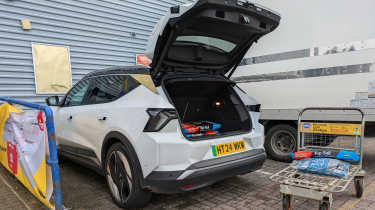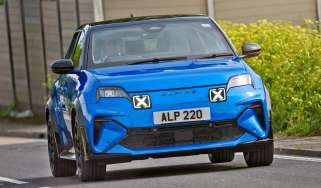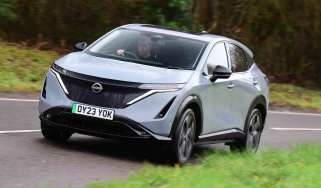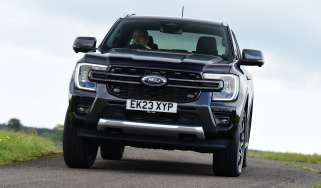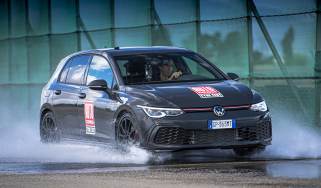Renault Scenic review
Our extensive testing of the electric Renault Scenic E-Tech reveals an innovative and hi-tech family car with few weak points

Our opinion on the Renault Scenic E-Tech
The Renault Scenic morphed from an MPV to an SUV in its latest guise. It turned into a purely electric car, too. It’s lost some of the interior flexibility but remains spacious and good value.
The large battery and efficient powertrain deliver competitive official range figures that we’ve been able to get very close to in our tests. Performance is moderate by current EV standards, but quick steering, a well-judged ride and reasonable agility make the Scenic a good choice for families. We love the sharp design and the modern cabin with its Google-based infotainment system and classy, sustainable materials.
Key specs | |
| Fuel type | Electric |
| Body style | Five-door SUV |
| Powertrain | 87kWh battery, 1x e-motor, front-wheel drive |
| Safety | 5-star EuroNCAP (based on the Renault Megane results from 2022) |
| Warranty | 3yrs/100,000 miles |
About the Renault Scenic E-Tech
The Renault Scenic E-Tech is part of a wide SUV range offered by the French company - if you class it as an SUV. While the Renault Scenic originally found fame as an MPV, the latest fifth generation model launched in 2024 is better thought of as a high-riding family car with SUV design elements.
Like the Renault Megane E-Tech that uses the same running gear, the Scenic E-Tech is electric only, and there are no all-wheel drive versions. If you want a 4x4 model, the Nissan Ariya, which uses the same platform, can accommodate you.
The Scenic has lost the fancy folding and sliding seats that you would expect from an MPV, replacing that practicality with a good deal more style, inside and out.
Used - available now
Every Scenic gets a sizeable 87kWh battery fitted because the 60kWh battery that was available from launch is no longer offered. There are three trim levels available: Techno, Techno Esprit Alpine, and Iconic Esprit Alpine. Importantly for UK-based EV drivers, a heat pump is fitted as standard on all models to help with cold weather range.
The base Techno model is still generously equipped. You get:
- 19-inch diamond-cut alloy wheels
- Front and rear LED lights
- 12.3-inch driver’s display
- 12-inch central touchscreen with Google software
- Dual-zone climate control
- Heated front seats and steering wheel
- Wireless smartphone connectivity
- Wireless charging
- Rear parking camera.
Moving up the range, the Techno Esprit Alpine takes a sportier approach with even bigger wheels for £3,000 more. It adds:
- 20-inch wheels
- Sports seats
- ‘Esprit Alpine’ badging inside and out
- Blue cabin accents.
- Grey fabric dash
- Electrically adjustable front seats
The plush Iconic Esprit Alpine costs £3,200 more but goes all-in with features including the Solarbay glass roof that can switch electronically from opaque to clear. These are the highlights:
- Harman Kardon sound system
- Hands-free parking
- 360-degree camera system
- Digital rear-view camera
- Solarbay panoramic glass roof
Renault Scenic prices and latest deals
Competitive pricing and generous equipment levels mean the Scenic offers good value for money when compared with its rivals. Even the top-spec Iconic Esprit Alpine version looks reasonably priced considering what you get.
Unsurprisingly, the Scenic E-Tech is more expensive than the last internal combustion-engined Scenic MPV, but since it launched prices have come down. The trim levels are priced as follows:
- Scenic Techno from £37,000
- Scenic Techno Esprit Alpine from £40,000
- Scenic Iconic Esprit Alpine from £42,000
The Renault Scenic is one of the cars that qualifies for the UK Government’s Electric Car Grant. The £1,500 discount is applied automatically, bringing prices even further within the realm of affordability.
Our Buy A Car service lets you spec your ideal Renault Scenic and choose the best offer from top dealers around the UK. Alternatively, you can lease a Scenic or buy a used model. We can help you sell your old car, too.
Electric motor, performance & drive
| Pros | Cons |
|
|
All Renault Scenic models come with an 87kWh battery and a 215bhp electric motor providing 300Nm of torque. Unlike its Nissan Ariya sibling, the Scenic is front-wheel drive only, which may be an issue for buyers who live in remote areas of the country susceptible to snow and ice in the winter.
There’s an apparent sporty edge to the Scenic courtesy of its firm ride and fast steering. It stays reasonably flat in corners without rolling too much to the sides. It’s more composed than many traditional, taller mid-size SUVs, but it’s not as agile or fun to drive as the best EV hatchbacks.
On our extensive long-term test of the Scenic, where we lived with the car for six months, we found it relaxing, competent and easy going from a driving perspective. Renault has judged the setup very well for typical family car buyers.
| Model | Power | 0-62mph | Top speed |
| Renault Scenic E-Tech | 215bhp | 7.9sec | 105mph |
Performance, 0-60mph acceleration and top speed
There is only one powertrain option in the Renault Scenic and its 215bhp output can get the car to 60mph in 7.9s. That’s more than fast enough for a car of this type and although there are family-focused electric cars with even more dramatic turns of speed, the Renault feels lively and responsive in everyday driving with a smooth, linear power delivery. It’s not unduly rapid or punchy off the line like some EVs.
The top speed of 105mph is relatively low, but the Scenic has absolutely no issues at legal UK motorway speeds.
Town driving, visibility and parking
Light, quick steering boosts the Scenic’s manoeuvrability at low speeds, but this is offset in town by a lack of all-round visibility. You sit low compared with some rival electric SUVs, while the rear window is narrow and the view is obscured by the large headrests in the back.
For those reasons, we’d recommend the top-spec Iconic Esprit Alpine model with its 360-degree camera system and the digital rear-view mirror. Not everybody gets along with digital mirror setups because it can be more difficult to refocus on the video screen than a conventional mirror. This is true of the Scenic’s system, but flipping to the unobstructed video view is a handy option to have.
Some cars have the camera for their digital mirrors mounted on the roof or tailgate, but the Scenic’s is behind the rear window glass. It can mist up as a result but you can use the rear wiper to keep it clear of rain and dirt. All Scenic models feature front and rear parking sensors.
The brakes can be a little sudden in their response but you soon become used to that, and stopping power is plentiful. The Scenic also comes with a one-pedal drive mode like its Nissan Ariya sibling. That means you can fully utilise the regenerative braking in stop-start traffic without needing to touch the brakes. It makes things a little more relaxing in town and helps to boost your overall efficiency and range.
B-road driving and handling
At motorway speeds, you’re aware that the Renault’s steering is relatively quick around the dead-ahead position and requires constant attention to ensure the car is tracking straight. This gives the impression that the Scenic has a sporty edge, as does a ride that is on the firm side - particularly on the 20” wheels we tested. This taut suspension is more to do with keeping the car’s weight in check than delivering an engaging drive.
A sub-two-tonne kerbweight doesn’t sound all that special, yet in the world of electric SUVs the Scenic is one of the lighter models on sale. This helps deliver quick responses, but there’s still some body roll in corners, and the firm suspension shudders over bumps that the best rivals can absorb easily. In our 2024 test against the Ford Explorer, the Scenic came out on top, but the Ford had the more comfortable ride.
The Scenic’s power delivery isn’t as forceful as in some EVs, but the front-wheel-drive set-up can still struggle to deploy what power there is, especially if you’re exiting a corner in the wet. The inside wheel can easily break traction and spin. Wheel-tugging torque steer is also an issue if you feed all of the power in at once.
Motorway driving and long-distance comfort
Refinement at motorway speeds is good, and wind noise is reduced on top-spec Iconic models courtesy of standard-fit acoustic glass. There is still some tyre roar to be heard, though.
Range, charging & running costs
| Pros | Cons |
|
|
Renault quotes a range of up to 381 miles on the official WLTP combined tests for the Scenic in Techno trim. This drops to 372 miles in the mid-range Techno Esprit Alpine, and 369 miles for the top-of-the-range Iconic Esprit Alpine.
During our tests with the Scenic, we’ve averaged an efficiency figure of around 3.4 miles per kWh. Our long-term test car posted returns as low as 3.1 mi/kWh in cold conditions for a predicted range of around 280 miles, but in the summer, we were able to get 340 miles out of the Scenic without too much effort.
All versions are fitted with an energy-saving heat pump as standard, which should help efficiency in the colder months of the year. There’s also a clever battery preconditioning feature that works seamlessly with the Google Maps navigation system. It optimises the battery temperature ready for scheduled charging stops on your programmed route and tells you how much charge you should add.
The maximum DC charging rate for the 87kWh battery pack is 150kW from a DC source. That means a 15 to 80 per cent charging time of 37 minutes. It’s a little slower than some rivals, with the Hyundai Ioniq 5 or Kia EV6 able to fast-charge to the same capacity in just 18 minutes at a sufficiently powerful charger.
The Scenic also supports three-phase charging, so a 22kW power source can fully top the battery up in just under five hours. Utilise a typical 7kW home wallbox charger and it'll take around 13 hours to fully recharge a Scenic.
| Model | Battery size | Range | Insurance group |
| Renault Scenic Techno | 87kWh | 381 miles | 33E |
| Renault Scenic Iconic Esprit Alpine | 87kWh | 369 miles | 34E |
Tax
The lowest Benefit-in-Kind (BiK) rate for EVs applies to the Scenic, and company car drivers will make savings over similarly specced rivals, courtesy of Renault’s competitive P11D costs.
Electric cars are no longer exempt from yearly Vehicle Excise Duty road tax, but both the entry-level Techno and Techno Esprit Alpine slip under the £40,000 threshold and avoid the additional luxury car tax. The top-of-the-range Iconic Esprit Alpine falls foul of this, so you'll need to pay the supplementary fee from the second year the vehicle is taxed until it is six years old.
You can still enter the London Congestion Charge area until 24 December 2025 without being charged, though.
Insurance groups
The entry-level Scenic starts in group 33, and goes up to group 34 for the priciest Iconic Esprit Alpine. Some rivals offer less powerful, smaller battery models that slot into lower groups. The Ford Explorer, for example, is in groups 20 to 32. Generally, Scenic insurance costs should be competitive with its direct alternatives.
Depreciation
Residual values for the Renault Scenic fall within the 54 to 58 per cent range after three years and 36,000 miles, which is towards the upper end of the electric SUV spectrum. The Techno models hold their value a little better than the higher spec cars.
The Nissan Ariya that shares the same platform as the Scenic has predicted residuals of between 43 and 50 per cent. Ford’s Explorer, meanwhile, is in the 46 to 51 per cent range.
To get an accurate valuation for a specific Renault Scenic model, check out our free car valuation tool...
Interior, design & technology
| Pros | Cons |
|
|
The exterior of the Renault Scenic taps into the themes of the Scenic Vision concept of 2022, designed by Gillas Vidal. The light units, front and rear, have an aggressive, bold look set off nicely by the large and interesting alloy wheels fitted on all models. The lighter paint colours available on the Scenic are the ones to choose in our view because they show up the car’s sharp surfacing better than the darker shades.
As with the old Scenic people carriers of the past, the latest electric SUV shares tech with the Megane, but adds more space into the mix.
Interior and dashboard design
The angular theme of the exterior continues inside. There’s an upright dashboard with a 12-inch portrait touchscreen and a 12.3-inch driver’s display in a landscape orientation.
There’s an interesting mix of materials. The top spec models have light-coloured fabrics for the seats and the dashboard, and there are darker trim options lower down the range that will better hide the inevitable marks and scuffs. The light materials contrast sharply with the black plastics, but it seems to work, the Scenic cabin feeling modern and high-tech rather than luxurious.
One gripe is with the driver’s air vent, which is of a different design to the others on the dashboard, and feels a little clunky to use. During our test, we struggled to get our phones to charge with the wireless charging shelf below the main screen.
Top-spec cars are fitted with what Renault calls its Solarbay roof. This is a panoramic glass panel that incorporates an electrochromatic layer that can turn from clear to opaque at the push of a button - or a shout at the voice control system. It transforms in steps from front to rear, which is a neat show for back-seat occupants to watch.
Materials and build quality
A range of different plastics and other materials are used throughout the cabin with a focus on sustainability. Traditional hard black trim is found on the lower doors and the centre console, with softer materials on the dashtop and upper doors.
The lighter soft-touch surfaces feel good and help create a light, soft and airy feel to the interior. The upholstery is made from recycled materials and is a classy substitute for leather, which isn’t even offered as an option. Even the steering wheel is trimmed in synthetic material, although it feels like soft leather in your hands.
Infotainment, sat-nav and stereo
The two large displays on the dashboard feature super-sharp graphics and neat animations, while there’s plenty of clear information on the driver’s display. This can be configured into different layouts, although we’d recommend choosing one and sticking to it. Switching from one to another can shuffle the layout around, leaving vital information such as your speed in a different position, which makes it hard to pick out. There are various colour themes offered, while the shortcut toggle switches beneath the main display are handy.
Renault’s OpenR Link system was closely examined in our 2025 car infotainment mega test. It performed well against nine of the market’s top systems, ranking in mid-table for levels of distraction and ease of use. It runs on a 12-inch portrait display in the Scenic and features crisp graphics, while the Google operating system will be familiar to many.
It’s quick to load, and the standard Google Maps software is just as effective as the firm’s Android Auto app when rerouting to avoid traffic problems. It includes information on charging locations and enables you to factor in charging stops when planning your route.
There are shortcut keys at the top of the main display to make navigating the system easier, while the climate controls use a mix of quick-access physical buttons and more in-depth touchscreen functions.
The steering wheel has an array of different stalks behind it for various controls, as well as control panels on its centre bar and a big button for the Multi-sense driving modes. If you invest some time to learn where everything is, it becomes intuitive quite quickly.
Renault recruited musician Jean-Michel Jarre to develop some sounds for the Scenic. The ‘VSP’ (vehicle sound for pedestrians) warns people when the car is approaching at speeds under 18mph. There’s also a welcome sound sequence when you turn the car on (that can be deactivated if you prefer). Sadly for 1980s electronica fans, Jarre was not involved in developing the nine-speaker Harman Kardon sound system on the highest-specification Esprit Alpine trim, but it still sounds great.
Boot space, comfort & practicality
| Pros | Cons |
|
|
The Renault Scenic might have the same platform as the Renault Megane, but its wheelbase is 10cm longer than the Megane’s at 2,780mm, and it has a much wider track, so there’s enough space inside for a typical family.
As in a lot of EVs, there’s a flat floor in the back, and rear cabin space shouldn’t be an issue even for tall adults. It’s important for buyers to realise that this Scenic does not, however, retain the flexible interior of its MPV predecessors. The rear seats don’t fold completely flat or slide but the cabin is roomy compared to SUV alternatives and the boot is large - if somewhat oddly shaped.
There are also a load of useful storage compartments around the cabin with over 38 litres in total - including a large 6.6-litre area in the centre console. There are big open cubbies in the centre console and wide door pockets. Both are great for dropping things in but they can make the cabin look a bit cluttered once they’re full of stuff because it’s all on show.
Dimensions | |
| Length | 4,470mm |
| Width | 1,864mm (2,085mm inc mirrors) |
| Height | 1,571mm |
| Number of seats | 5 |
| Boot space | 545 litres |
Dimensions and size
The Renault Scenic features a typical compact SUV shape, although it does have a lower roof than most rivals to help it cut through the air more effectively. The long wheelbase creates plenty of space inside, while the wide track also helps.
To underline the point that the Scenic is lower than the typical SUV, a Ford Explorer is almost exactly the same length as the Scenic and slightly narrower, but 60mm taller. The Volkswagen ID.4 is 114mm longer, 12mm narrower and 70mm taller.
Driving position, seats & space in the front
There’s a wide range of seat and wheel adjustment, but longer-legged drivers might find their left knee makes contact with the protruding tray beneath the touchscreen, where the wireless phone-charging pad is located. The low centre console makes it possible to clamber across the cabin and adds to the general spacious feel.
The centre armrest has 6.6 litres of space beneath, while the glovebox isn’t spoiled by having the fusebox cutting into it. The lined door bins are an upmarket touch that stops items rattling around inside.
Seats & space in the back
Headroom and legroom are fine in the back of the Scenic and a real upgrade over the smaller Renault Megane. The front seats are slim to maximise legroom, but a lack of foot space under them means rear passengers can’t stretch out. Combined with low seat cushions that provide limited under-thigh support, it means long trips could still prove to be uncomfortable for adults.
The middle seat is narrow and set quite high, so it’s best left for occasional use. If you’re not using it, the backrest folds down to reveal a neat multifunction armrest that kids will enjoy. This features cup holders, USB-C charging sockets and some storage space, but also two device holders.
These holders position smartphones where they can be easily viewed by occupants of the outer rear seats. We expect they will be used mostly by children, and with this in mind, they seemed reassuringly sturdy. Just be warned that tablets in chunky protective cases won’t fit.
As with most family cars, you get two Isofix points located on the outer positions of the rear seat. These are easy to slot a child seat into thanks to their sturdy plastic surrounds.
Boot space
The boot space is quite narrow and there’s a bit of a load lip to negotiate to lift heavy items into the back of the Scenic, but the actual space on offer is generous. The boot capacity is 545 litres in five-seat mode, and this increases to 1,670 litres with the back seats folded. A Ford Explorer has a 470-litre boot, while the VW ID.4 offers 543 litres.
The 40:20:40-split rear bench offers some useful versatility, but the seats don’t fold flat as they did in the MPV Scenics of old. There’s a big lip created by the seat backs, which can be tricky when sliding bulky items inside.
If this is likely to be an issue for you, a double-height boot floor is available as part of the EV Pack (£335). It creates a flatter load floor with three compartments beneath instead of the usual single space, but reduces capacity of the main boot area.
As standard, the single under-floor storage area will easily swallow two charging cables and still leave space for more stuff. There’s no ‘frunk’ storage in the car’s nose.
Towing
All versions of the Renault Scenic have a maximum braked trailer towing capacity of 1,100kg. That’s above two-wheel drive versions of the Volkswagen ID.4, but behind the Kia EV6, which can pull a caravan or trailer of up to 1,800kg.
“The under floor storage space in the boot is so deep you can just fling the cable in without worrying about coiling it up, a really useful feature for lazy EV drivers like me. Just remember to leave the charging cable accessible when you load the boot up for a long trip or you’ll have to unload to get at it.” - Steve Walker, head of digital content.
Safety & reliability
| Pros | Cons |
|
|
Renault has been a consistently strong performer in the Euro NCAP tests, and the Scenic earned a five-star rating in 2022. All trim levels feature a strong line-up of safety kit, including adaptive LED headlights, blind-spot warning and adaptive cruise control. The Iconic Esprit Alpine model adds some clever tech in the shape of 360-degree cameras and an automated hands-free parking system.
It’s compulsory for all new cars to feature electronic safety systems that reset to ‘on’ every time you climb aboard. One of the big tests for manufacturers these days is how easy it is to deactivate systems you feel are excessively intrusive, with their assorted warning beeps.
In the Scenic this process is refreshingly simple because a button to the right of the steering wheel can select all your preferred driver assistance settings with one press. It’s a neat solution that other manufacturers who bury the controls in sub-menus could learn from.
| Key standard safety features | Euro NCAP safety ratings |
|---|---|
|
The Renault Scenic has yet to feature in our Driver Power customer satisfaction survey but Renault as a brand is on the up. The French firm came 29th out of 32 manufacturers in 2024 but improved markedly to 6th place overall in 2025 with a satisfaction score of 86%. Customers were particularly happy with the safety features, exterior design and value for money of their cars.
Buying and owning
- Best buy: Renault Scenic Techno
We recommend the entry-level Techno trim level as the best buy in the Scenic range. It holds its value better than the upper trim levels, the smaller wheels enhance the ride quality compared with the larger wheels fitted to pricier trims, plus you get the same powertrain and infotainment system as the rest of the Scenic line-up.
It’s also quite expensive to step up the Scenic’s trim level range to the Techno Espirit Alpine and Iconic Espirit Alpine models. The digital rear-view mirror and Solarbay panoramic roof on the top-spec cars are well worth having, but probably not for £5,000 over the base car.
Renault Scenic alternatives
The electric SUV class is packed with competition, including the big-selling Tesla Model Y, plus the Ford Explorer and Ford Capri, the Skoda Enyaq, Volkswagen ID.4, Toyota bZ4X, Kia EV6 and Hyundai Ioniq 5. Arguably the closest rival to the Scenic E-Tech is the Nissan Ariya, which uses the same running gear.
The big advantage that the Scenic has over these rivals is pricing. It offers nearly as much range as the Tesla or Fords, but has a bit more space. It’s also less expensive than any of them but doesn’t offer quite the same urgent performance.
Decent efficiency means the Scenic can travel further on a charge than the Toyota, and the onboard tech is more user-friendly than the systems in the VW Group models. The Hyundai Ioniq 5 and Kia EV6 offer faster charging.
Renault Scenic Iconic Long Range long-term test
Our head of digital content, Steve Walker, ran a Renault Scenic Iconic Long Range over a six-month long-term test. Having previously had a smaller Megane E-Tech, the additional space of the Scenic has been welcomed by his two children, who found the Megane a little cramped.
It proved to be a versatile family car with strong efficiency. The easy charging cable storage is a real benefit, though the high-loading lip and narrow boot space have been a little bit of a pain when loading the golf clubs. The light interior trim on the Iconic model he tested did pick up a few marks but generally the materials proved robust and well put together. You can read the full long term test here...
Frequently Asked Questions
The Scenic’s warranty of three years or 100,000 miles is a little above the industry standard of three years/60,000 miles, and you get roadside assistance for the duration. In addition, the Scenic’s E-Tech powertrain has four years and 100,000 miles of cover, while the drive battery has cover for eight years and 100,000 miles.




